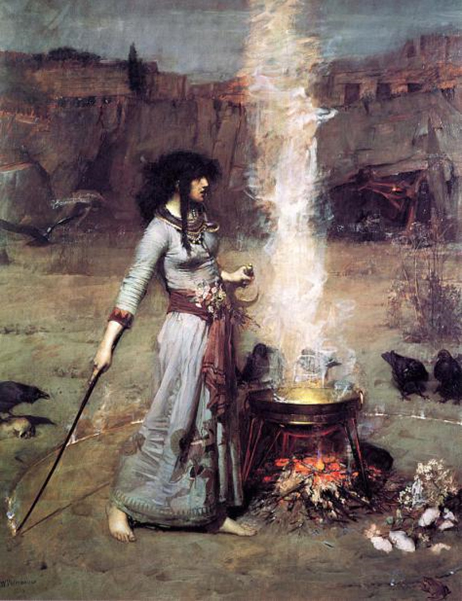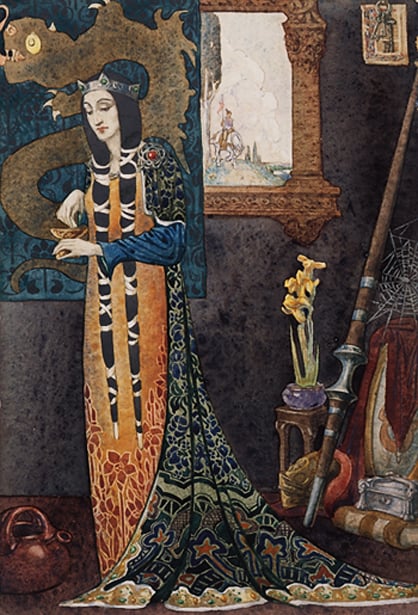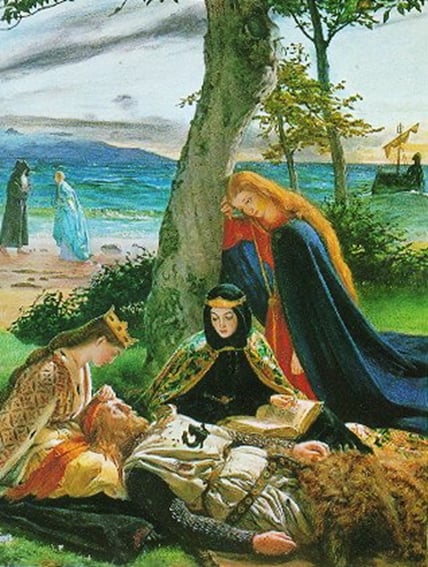
The Bewitching Tale of Morgan le Fay, a Captivating Character of Arthurian Legend
The legendary Morgan le Fay is quite often mixed with the Celtic goddess Morrigan. The two strong females seem to be separate women, but there is also a possibility that they are linked with each other.
Morgan le Fay is also known as Morgana, Morgane, Morgan le Faye, etc. She is said to be a powerful enchantress, and is also a character of the Arthurian legend. She became very popular in the modern world because of a novel by Marion Zimmer Bradley called The Mists of Avalon. The old legends, with roots in medieval times, had been transformed into the monumental novel, which conquered the hearts of millions of readers.
Morgan probably appears for the first time in literature in The Life of Merlin by Geoffrey of Monmouth (1100 -1155 AD). This text became one of the classic books connected with the Arthurian legends. Among the stories about knights and adventures, Morgan is portrayed as an evil character. She is the one often who leads the heroes of the legends into danger. She is also a very sensual part of the stories, as a woman who tried to seduce men.

Morgan Le Fay by John R. Spencer Stanhope. (1880) (Public Domain)
The Goddess Morrigan
Morrigan, a Phantom Queen, is a goddess strongly connected with Irish and Celtic mythology. She is associated with fate and known as a goddess of war and death, but also fertility and numerous other things. She appears as a crow on the battlefield in legends. She is also linked to the Valkyries. Additionally, she is described as a triple goddess, called ''the three Morrigan''.
There is still an open discussion between the specialists in legends, myths, and literature about the connection of Morrigan with the Arthurian Morgan. It is quite possible that the literary character may have been inspired by old Irish tales about the goddess Morrigan. What's more interesting, language specialists suggest that the name of Morgan comes from Morrigan - which may have its roots in the words ''greatness'' and ''terror''.
- The Arthurian Tale of Elaine of Astolat, Lady of Shalott
- The Grail Cypher: A radical reassessment of Arthurian history
- Researchers Claim Glastonbury Ancient Legends Made Up By Cash-Strapped Monks
Stories of a Dangerous Witch
In medieval stories, Morgan le Fay is one of the most popular, intriguing, and magnetic women connected with the Camelot court. It is unknown if she was a historical person. For centuries she was considered as a real woman who lived in different parts of Britain. She was believed to be a healer, enchantress, and a mysterious woman with many spiritual talents. Some people called her a “wise woman”, which could also mean witch.

“The Magic Circle” by John William Waterhouse. (1886) (Public Domain)
In late medieval stories, the picture of a good woman who served the people with her talents had changed. Morgan started to appear as the daughter of Lady Irgraine and her first husband Gorlois – and King Arthur was her half-brother. She was also an adviser to Arthur and the Knights of the Round Table.
According to the legend by Thomas Malory (1415 – 1471), she was unhappily married to King Urien. At the same time, she became a sexually aggressive woman who had many lovers - including the famous Merlin. However, her love of Lancelot was unrequited. Morgan appeared also as an indirect cause of Arthur's death.

“Morgan le Fay,” by Christian Waller (1920). (Art Gallery of Ballarat)
Her role expanded in the 13th century in the Vulgate Cycle and Post-Vulgate Cycle. During this period, Morgan became an anti-heroine. She was described as a malicious, cruel, and ambitious nemesis of Arthur. These stories say that Morgan had been sent to a convent to become a nun. However, this was the place where she apparently started her study in the art of magic.
With time she became Merlin’s lover and he taught her witchcraft. Morgan was a very good student and soon became a powerful witch. It is possible that parts of her story were inspired by the motifs of Medea who killed her rival for Jason's affection, and Deianira who sent a poisoned tunic to Hercules.

“She was known to have studied magic while she was being brought up in the nunnery.” (1914) By W. H. Margetson from: Legends of King Arthur and His Knights. (University of Rochester)
One of the most important parts of her story is her affection for Lancelot. She used all of her knowledge, drugs, and enchantments to try to have Lancelot for herself. In the stories he appears as a strong hero who doesn't allow the beautiful witch to break his rules.
- Ultraviolet light reveals hidden text in ancient book of Arthurian stories
- The Legendary Origins of Merlin the Magician
- Bardsey Island - Haunting Island of Spiritual, Natural, and Cultural Significance
Nonetheless, she manages to capture him under her spell and keeps him in prison, but when he gets ill and is near death she releases him. There are many different variations of this story - in some Morgan appears as a sexual evil, in others as a lost woman who really loves Lancelot.

Morgan le Fay by Edward Burne-Jones. (1862) (Public Domain)
The Last Show by the Lady of Avalon
The final version of her legend concentrates on witchcraft. Morgan is described as a witch who uses her spells to reach her own goals. In these tales, she has gained an ability to transform herself into a crow, horse, or any other animal. Usually, the animals are black.
It is likely that this version of the legend connected Morgan with the goddess Morrigan. Compared to different stories, this time Morgan vanishes for a long time and Arthur begins to believe that she is dead. However, one day he meets her again and she declares her plan to move to the Isle of Avalon to live there. Arthur discovers that the rumors about a secret love affair between her and Lancelot were true. Then the goddess Fortune appears, and foretells Arthur's death.
The story ends with Morgan as a lady in a black hood, who takes the dying Arthur to his final resting place in Avalon. She seems to be strongly connected with death, but is like a person who doesn't belong to the world of the dead nor the world of the living.

The Death of King Arthur by James Archer. (1860) (Public Domain)
Morgan le Fay Dressed in High Heels
It is unknown if the legend about Morgan le Fay was highly inspired by Morrigan, or the similarities are caused by coincidence. Celtic mythology is not easy to understand and several stories may be applied to different people.
Regardless, Morgan le Fay became an icon of pre-Roman and pre-Christian stories. She is also a popular character in modern pop-culture. Artists still record songs, create paintings and drawings, and write books to commemorate the magnetic medieval woman known as Morgan le Fay. Nowadays, she is always presented as a beautiful woman dressed in a very attractive way. She appears to be an icon of medieval sexual desires.

Morgana Le Fay, Anikó Salamon's art for the video game King Arthur II. (CC BY-SA 3.0)
No matter if she was real person, or only a legend, she is undoubtedly one of the most famous women of medieval Northern Europe. She continues to be recognized as a magical force in the mysterious phenomenon called Fata Morgana - a form of mirage common off the shores of Sicily.

Queen Morgana Loses Excalibur His Sheath, Howard Pyle's illustration from The Story of King Arthur and His Knights. (1903) (Public Domain)
Featured image: Morgan le Fay by Frederick Sandys. (1864) Source: Public Domain
References:
Lucy Allen Paton, Studies in the Fairy Mythology of Arthurian Romance, 1903.
Carolyne Larrington, King Arthur's Enchantresses: Morgan and Her Sisters in Arthurian Tradition, 2006.
https://www.academia.edu/6129549/The_Role_of_Women_in_the_Arthurian_Material
http://www.arthurian-legend.com/morgan-le-fay/
https://www.academia.edu/8161437/Morgan_le_Fay_and_the_fairy_mound_in_Sir_Gawain_and_the_Green_Knight















Comments
But what about goddess Modron from the Welsh myth? Morgan and Modron share a lot more than Morgan and the Morrigan. They were both married to Urien, they are both mothers of Owain and they both are related to the Avalon/Afallach (who was her father).
While it is true that "Le Fay" comes from the French for fairy, it is but another supporting element of the transition from Celtic and Irish myth to Medieval and Middle English. The alteration from goddess to fairy is similar to many alterations made by the English for the purpose of transforming a tale into one that expresses their own concerns as a society.
but I wouldn't say that Kaamelott is "de la camelote"
"Le Fay" is but the anglicism for french "la Fée" (the Fairy). For the arthurian tales were initially written by french authors. Sorry, folks.
Very good article, though it failed to mention the supposed link between Morgana le Fay and the Lady of the Lake, as well as the theory that Morgana herself followed the Celtic matriarchal ‘old’ or ‘pagan’ religion. This would surely have cast her in the role of ‘villain’ when one takes into account the changing culture of Britain at the time – from pagan to Christian.
- Moonsong
--------------------------------------------
A dreamer is one who can only find his way by moonlight, and his punishment is that he sees the dawn before the rest of the world ~ Oscar Wilde